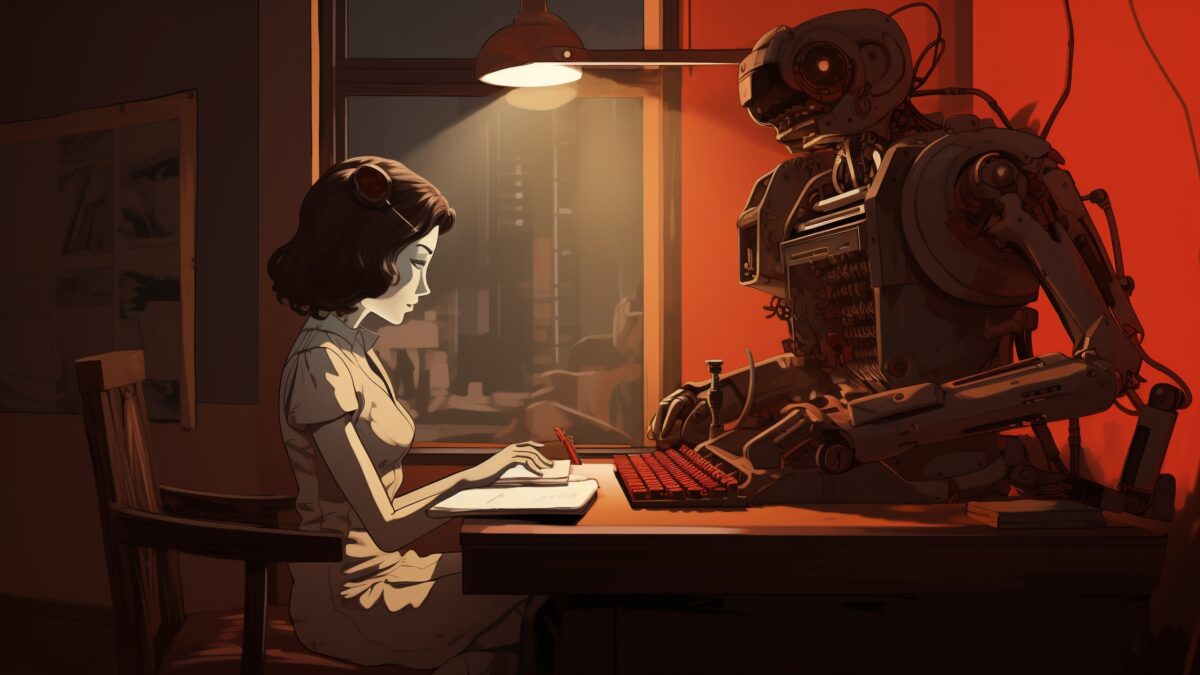The long running strike action by the Writers Guild of America against the Alliance of Motion Picture and Television Producers, which was more recently joined by the Screen Actors Guild, has drawn attention to the role of artificial intelligence in the future of film and television productions. Given the speed and significance of developments in generative artificial intelligence, they are right to be concerned, as are all creative workers.
Both the writers and actors are concerned that unless they can secure a binding agreement with the studios, films and TV shows will increasingly be written with scripts produced using AI, and featuring “human” characters generated through AI. These content producers see AI as a tool that can be used by Hollywood producers to replace labour in order to reduce production costs.
Creative AI is already among us
Such concerns are growing throughout the creative industries. It was recently revealed that News Corporation Australia was using AI to produce 3,000 news stories a week for local newspapers. In the music industry, Nick Cave has used his blog The Red Hand Files to rail against the capacity of ChatGPT to produce a “song in the style of Nick Cave”, replete with lyrics dealing with sinners and saints, demons and saviours, and devils and angels. Cave argued that such songs could only be “a replication, a kind of burlesque”. (He also said that the song ‘sucked’).
Defending the relationship between experience and art, Cave argued that great songs could only come from an “authentic creative struggle”, as a “redemptive artistic act that stirs the heart of the listener, where the listener recognizes in the inner workings of the song their own blood, their own struggle, their own suffering”.
Creative AI and the death of the author – also actors, editors, designers…
This is a very different conversation about creative work from discussions in the early 2000s. Following on from the UK’s innovative creative industries policy strategies developed under Tony Blair’s government, there was much focus on the vital power of creativity and the unique – if unruly – capabilities of creative people. Creativity was the resource that could not be owned or produced: in order to develop a creative economy, you needed to be an attractor of the creative class, through a place-based mix of cultural vibrancy, tolerance of diversity, and perhaps some hipster bars and bike paths.
There was also confidence that whatever jobs would be overtaken by what Martin Ford termed the “rise of the robots”, they would not be the creative ones. The highly influential Oxford Martin School study of the threat of computerisation to employment, undertaken by Carl Benedikt Frey and Michael Osborne in 2013, found that routine jobs with low levels of cognitive skill were indeed threatened by digital technologies.
The technological threat applied to obvious candidates such as supermarket checkout workers, but also to significant entry-level jobs in legal fields and accounting. But if the position required what Frey and Osborne termed “creative intelligence” – a mix of creativity, social intelligence, and the ability to perceive changes and adapt to them – then it was deemed to be largely safe from computerisation. Event planners, business strategists, surgeons, dentists, fashion designers and artists, writers and performers could apparently rest easy.
A decade on from the Oxford study, it is all too apparent that artists, writers, and performers cannot avoid the threat presented to their work by AI. Programs such as ChatGPT, NVIDIA Deep Learning, Midjourney and many, many others are accelerating their capacity to produce content as good as that produced by creative professionals.
Nick Cave is right to say that the experience of hearing a song such as The Mercy Seat is enhanced by an awareness of the experiential journey that he and other members of the Bad Seeds/Birthday Party had in recording such an intense production. Jackson Pollock’s “Blue Poles” is not “something a 10 year old could do”, as I can still hear my father saying when it was originally purchased by the National Gallery of Australia. There is a complex relationship between the inner journey of the artist and what appears on the canvas, in this case a leading work of abstract expressionism.
The power of Indigenous writers such as Yankunytjatjara poet Ali Cobby Eckermann comes from the inter-generational experience of living as an Indigenous person on Australian lands. The “death of the author” proposed by poststructuralist critics such as Roland Barthes becomes, as Aiden Coleman has argued, an “erasure of difference” and the “truth of her identity … [that] is central to her work”.

High art, low income
But the open secret of the creative industries is that, for the most part, its practitioners do not make a living producing high art. Just as professional photographers have long earned income taking wedding photos, writers produce genre fiction and corporate copy, script writers work on sitcoms and soaps, and actors do TV commercials.
It is at this level of work, that pays the bills, that AI threatens the labour market position of creative workers.
It is the relatively mundane yet routine creative work that is generative of future AI models, worsening the deteriorating conditions of work and employment. These are also the forms of creative work least likely to be captured by copyright protections, which focus upon work that is unique and original.
If one were to have predicted where the major industrial relations battlegrounds of the 2020s would be, the temptation would have been to look at traditionally highly unionised industries such as construction, mining, or transport. But it has turned out to be around creative work, and the future of employment and conditions in the creative industries, where the most intense battles between employers and workers are now being fought.
This article is republished from Sydney Business Insights under a Creative Commons license. Read the original article.
Images were generated in Midjourney using a paid plan within their Terms of Service.